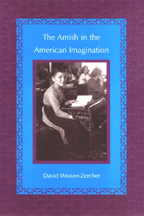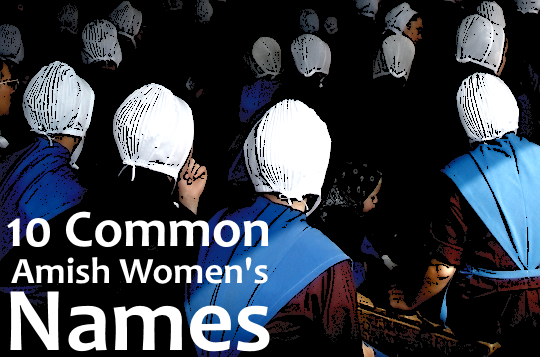An Amish America Q-and-A with Professor David Weaver-Zercher
David Weaver-Zercher is chair of the Department of Biblical and Religious Studies at Messiah College in Grantham, Pennsylvania. He is also the author and editor of numerous publications on the Amish, including The Amish in the American Imagination, Amish Grace (with co-authors Donald Kraybill and Steven Nolt), and Writing the Amish: The Worlds of John A. Hostetler.
His latest book, The Amish and the Media (edited with Diane Zimmerman Umble) examines the Amish from two angles: as the subjects of media, and as producers and consumers of it. It covers a range of fascinating topics such as the Amish approach to giving interviews, Amish on reality TV and in documentaries, as well as the role of Amish-produced newspapers in sustaining Amish society.
As someone running a blog on the Amish, I have been particularly interested in Professor Weaver-Zercher’s work and was pleased to have a chance to ask him some questions. A sincere thanks to him for taking the time to contribute!
AA: First of all, I’m curious about when you first became interested in the Amish and how?
DWZ: I grew up in Elkhart County, Indiana, so I’ve always known about the Amish. When you grow up in a place like Elkhart County (and I lived along a rural road with some nearby Amish neighbors), you tend to have a less romanticized view of Amish life than others may have. The Amish were different, yes, but they were also my friends and neighbors—not a culture to explore, interpret, and explain.
I didn’t become interested in the Amish in a scholarly way until I went to graduate school at UNC-Chapel Hill in the early 1990s. In my graduate program, I encountered a burgeoning literature on the commodification of American religion, and it occurred to me that no one had explored that theme very fully with respect to the Amish. The more I looked into it, the more I became convinced that a good dissertation was needed. That dissertation eventually became my first book, The Amish in the American Imagination.
AA: In that book, you detail the ways that Amish have been interpreted and in some cases co-opted by non-Amish Americans for the benefit of various personal and group agendas. You point out that this usually reveals more about the interpreters and presenters of the Amish than the Amish themselves.
I’m curious in what ways you have seen this played out in the years following the publication of the book, particularly in regards to two recent phenomena: the public and media interest in the Rumspringa period of Amish life, and in the reaction to the 2006 Nickel Mines shooting and its aftermath?
DWZ: The intense public interest in Rumspringa was actually catalyzed three years before my first book was published—by the “Amish drug bust” case in the summer of 1998, when two Lancaster County Amish youth were arrested for selling cocaine to other Amish youth. Obviously some outsiders were aware of Amish Rumspringa before that event came to light, but the international news coverage of the arrest multiplied that awareness.
Some people complained that the media attention was unwarranted; they (rightly) suggested that, had the young men been Presbyterians instead of Amish, their religious backgrounds would never have been part of the story. But that complaint ignores the elements that make news stories “newsworthy” in the first place—in this case the juxtaposition of common assumptions about Amish asceticism and this “new” image of carousing, drug-using Amish teenagers. The media loves these sorts of stories, as do the people who devour the media’s offerings. There may be some truth to the claim that Americans love to see the “righteous” fall, and that’s what gave the drug bust story its power. But I really doubt most readers found joy in seeing the shortcomings of Amish life; rather, they found the events surprising and ironic, and they wanted to know more.
That, of course, opened the door to additional media portrayals of Rumspringa, most notably the documentary film Devil’s Playground and the reality-television series, “Amish in the City.” Of the two, Devil’s Playground was by far the more compelling portrayal. It was less contrived than “Amish in the City,” and it provided an honest and heart-wrenching look at the far edge of Amish youth culture. “Amish and the City” tried to portray the perennial Amish decision (to remain Amish or to leave) in a dramatic fashion, but it largely failed. On the other hand, Devil’s Playground succeeded wonderfully at portraying the difficulty some Amish youth have in facing that question.
That’s not to say that Devil’s Playground did everything right. In fact, I agree with critics who complained that the documentarians weren’t forthcoming enough about the atypical nature of their particular Amish story. To be sure, some Amish youth in Northern Indiana have wild barn parties, drink beer, and sleep around, but that experience is hardly typical of North American Amish teenagers. Of course, if you want to film a documentary that features real Amish kids, you aren’t going to convince the more sedate Amish youth to take part; and even if you do, they aren’t going to perform in the ways that make them Hollywood material.
As for the attention devoted to the school shooting, it was again the surprising incongruity that generated the story—in this case, the awful reality that an Amish country school was not immune from horrific gun violence. Of course, that initial story was quickly superseded by the story of Amish forgiveness—again, a surprising act that caught many people off-guard. Observers around the world were simply amazed that the Amish community could extend forgiveness so quickly in the face of such heinous evil.
I continue to have mixed feelings about the way the forgiveness story superseded the violence story. As someone who believes forgiveness is a good thing, the Amish example was inspiring on a number of levels, and people continue to ponder the possibilities of forgiveness due to the Amish witness. At the same time, the forgiveness story took the focus off the violence when, in my view, the issues raised by the violence (e.g., rampant violence against women, America’s gun culture, etc.) deserved to be explored more extensively, not simply dropped. In other words, it seems to me that the extension of Amish forgiveness allowed observers who were disturbed by the violence to bring “closure” to this senseless act of violence when in fact quick and superficial closure was not warranted. And the media was more than happy to provide their consumers with a “happy” ending. I myself would have hoped for less closure and more reflection not only on forgiveness, but on the violence that occasioned the Amish response.
AA: In Amish Grace, you and co-authors Kraybill and Nolt discuss the aftermath and media  reaction to the shooting. As we know, Nickel Mines and its environs were swamped with media in the days following the attack. Some articles recounted the trickiness of covering a group that didn’t particularly appreciate the attention.
reaction to the shooting. As we know, Nickel Mines and its environs were swamped with media in the days following the attack. Some articles recounted the trickiness of covering a group that didn’t particularly appreciate the attention.
Are you aware if life has returned to something resembling normal for this community, at least with regards to attention from outsiders? Have you heard if there are any Nickel Mines movies or anything like that in the works or is that sort of thing being avoided?
DWZ: I’ve not visited the Nickel Mines community in over a year, so I don’t have much to say about your first question. From conversations with other Lancaster County Amish people, my sense is that the Nickel Mines Amish have gotten back to their routines and, as much as possible, don’t dwell on or recount the events of October 2, 2006. Needless to say, the lives for the individual families involved will never be the same.
I know that outsiders continue to seek out Nickel Mines, if only to drive around the community and see where the school (now torn down) was located. I haven’t heard any reports of people being overly intrusive, though as I said, I haven’t visited or talked to the Amish people in that area to really find out.
As for a possible movie, a Hollywood production company recently bought the rights to Amish Grace from our publisher. We’ve since heard that they’ve had representatives visit Lancaster County to see if a feature film can indeed be shot there. I’m not sure what will come of that, though I suspect a feature film of the Nickel Mines school shooting will someday be produced.
AA: It often seems that the Amish stories which get the most attention in the media are those which play up the good-and-evil dual nature of man. You often see the isolated abuse stories getting a disproportionate share of media play—I’m thinking of a recent rape and incest story, puppy mill coverage, and the 20/20 piece ‘The Secret Life of the Amish’ which you discuss in The Amish in the American Imagination.
On the other end of the spectrum you have the laudatory articles which idealize Amish life, most prominently in the forgiveness accounts after Nickel Mines. Not infrequently, one finds comments on message boards and blogs which can be described as downright vile in their dislike for the Amish. More often you see reactions pointing the other way, with writers idealizing Amish culture to the point of expressing a desire to join. Could you comment on why you think the Amish attract such strong and disparate reactions among the public?
DWZ: Perhaps the simplest way to answer your question is to acknowledge that Amish life is multifaceted. There are many things to highlight, and like most cultures, some of the features of Amish life are attractive to outsiders and others are unattractive.
Many people, including most scholars of Amish life, try to acknowledge the complexity of Amish life. For my part, I often note that some of the more “attractive” aspects of Amish life are connected to some of the “unattractive” aspects. For instance, the strong intergenerational ties one finds among the Amish are nurtured and enabled by the community’s unwillingness to allow their children to pursue education beyond the eighth grade. Obviously an observer can choose to emphasize one aspect over the other—and many observers do, which is why we see the disparate reactions you cite.
Related to that, these strong reactions often reinforce themselves in a dialectical process. The romanticized versions of Amish life lead those who are less than enamored with Amish life—including ex-Amish church members—to “correct the record” in ways that are often just as one-sided. That in turn gives purpose to those who consider themselves defenders of Amish life. And so it goes.

Nappanee/Amish Acres map: uwec.edu
AA: As you mentioned, you grew up in northern Indiana and in a quite amusing preface to The Amish in the American Imagination you point out that you once worked at the tourist attraction ‘Amish Acres’ at Nappanee, and that the book could be seen as a form of penance for that youthful stint of employment.
I was wondering if you could comment on the role that Amish Acres and other tourist attractions play in public perceptions of the Amish, i.e., do they serve to reinforce perhaps misguided stereotypes of the Amish (I’m thinking Plain and Fancy), to what degree can they be seen to counter those stereotypes, and what is the typical tourist in search of when visiting these establishments?
DWZ: It’s hard for me to speak generally of tourist attractions and what they do, since I’ve visited relatively few of them. From my limited sample, I’ve been favorably impressed by the presentations I’ve heard and the information I’ve received. Tourists who are genuinely interested in learning about Amish life are well served in these establishments by able, intelligent interpreters.
Many tourists, however, are not all that interested in learning about Amish life. They travel to Lancaster County (and other Amish areas) for reasons that have relatively little to do with learning about the Amish: they enjoy the rural landscapes, they want to relax and eat good food, they visit outlet malls and other commercial establishments, and they purchase souvenirs to validate their travel. Some tourist establishments have gift shops that cater to these recreational tourists, and these shops often carry things that don’t advance their educational purposes, and in some ways undermine those purposes.
For instance, it’s very easy for these tourist enterprises to connect Amish life to country decor or, as Susan Beisecker-Mast has argued, to an imagined Victorian American past. In these renderings, the Amish themselves become fashioned as throwbacks to what people imagine America was like in the nineteenth century (a Walt Disney-like Main Street America). Rather than seeing the Amish for what they are—twenty-first century Americans who have chosen a challenging path of cultural resistance—the Amish as seen as people who have maintained a lifestyle from another time and represent the imagined values of that bygone era. This is what I call the domestication of the Amish. In my view, the Amish are much more radical than that.
AA: Could you give an idea on Amish opinion regarding tourism in general?
DWZ: Generally speaking, most Amish people are not thrilled with Amish-theme tourism. That is, if they could wish it all away, most of them would. Tourism increases traffic in Amish areas, and it thereby compromises their safety on the road. Even more problematic is the intrusiveness of some Amish Country tourists. I wouldn’t like people taking pictures of me without my consent. Why would Amish people working in their fields or walking along the roads feel any differently?
Still, I think it’s important to qualify my assertion that Amish people don’t like tourism. There are at least two ways in which Amish-theme tourism actually benefits some Amish people. First, tourists spend money, and some of that money goes to Amish vendors (who sell quilts, fruits and vegetables, and many other products to tourists). Indeed, some Amish families in tourist regions have used those sources of income to keep a farm in the family and/or purchase new farms for their children. Second, some tourist establishments have the positive effect of informing outsiders about the Amish life and, in some respects, keeping them from being even more intrusive. Before these tourist establishments were built, curious outsiders were more likely to show up at an Amish farm and ask to look around; at least now there are places for tourists to learn about Amish life that keep them at a remove from actual Amish people.
 AA: The Amish and the Media, which you co-edited and contributed to with Diane Zimmerman Umble, examines the Amish in the media, and as creators and consumers of media. Regarding the first category, Amish often appear quoted in media stories under their actual names, and even allow their photos to be taken (usually unposed, but taken nonetheless).
AA: The Amish and the Media, which you co-edited and contributed to with Diane Zimmerman Umble, examines the Amish in the media, and as creators and consumers of media. Regarding the first category, Amish often appear quoted in media stories under their actual names, and even allow their photos to be taken (usually unposed, but taken nonetheless).
One would think that this would run counter to the humility emphasis. Amish correspondents to the publication Family Life, and even those who write full-length pieces for the monthly, often omit their real names or simply sign their initials. Would these news-story examples be atypical cases of more progressive Amish, reporters taking advantage of Amish trust, or something else?
DWZ: I’m not sure I agree with your assessment that Amish people “often” appear quoted in media stories. That happens sometimes (and it happened more often in the aftermath of the Nickel Mines shooting than it typically does), but many Amish people remain very reticent to have their names cited in a newspaper or magazine. When Amish people’s names do appear, I think your assumptions above are correct – these named informants are often boundary-pushing Amish people and/or persons who may not have been aware that their names would end up in print.
As for Amish people who show up in re-produced photographs (newspapers, magazines, tourist literature, etc.), you make an important distinction: Amish subjects rarely, if ever, pose for those photographs. In fact, there’s something of a tacit agreement between Amish people and photographers, at least in the larger settlements: Amish people won’t pose for photographs, but neither will they strenuously object to being photographed. If a photographer gets too pushy, the Amish may object, but typically they don’t, which I interpret as an example of their humility. Rather than assert their will, they will humbly allow their photographs to be taken. And of course, the photographers are safe in knowing the Amish won’t file lawsuits against them.
AA: With the recent slew of media coverage on the Amish, do you feel that the typical American has a more or less accurate picture of Amish society today than he/she did, say, circa Witness?
DWZ: I’m going to re-cast the options you gave me for an answer here: I would suspect that Americans are both more informed about Amish life and more misinformed at the same time. That may sound like a contradiction, but I think it’s possible to have a greater familiarity with a group and, by virtue of that familiarity, possess more incorrect information about them.
Here’s a non-Amish example: my seven-year-old son’s knowledge of baseball. A few years ago, Samuel knew nothing about baseball beyond the fact that you swung a bat at a moving ball. Since then, he’s learned a lot about the game, both by playing it and by becoming interested in some major league teams and their players. So Samuel definitely knows more about baseball than he did a few years ago. At the same time, he’s more likely than he was a few years ago to tell me things about baseball that are just plain wrong. He’s both better informed, and more misinformed.
I suspect the same is true of Americans and Amish life. With all the media explorations of Amish life since the 1980s—and particularly with the media coverage of the Nickel Mines shooting—most Americans are familiar with the broad outlines of Amish life (e.g., plain dress, horse and buggy transportation, and rural living). At the same time, many of these same people carry incorrect assumptions about the Amish, assuming for instance that the Amish are more secluded from the broader society than they really are.
AA: In what typical ways do the media distort the public’s view of the Amish? And any particularly good recent renditions of the Amish in the media you could point out?
DWZ: The distortions that come to my mind tend to be portrayals that lack nuance. I’ve already talked about media portrayals for Rumspringa, which typically focus on the most extreme examples in some of the larger Amish communities. These portrayals are “truthful,” but they focus on a relatively narrow slice of Amish life without noting the variety of Amish youth cultures. Some media demonstrate the same lack of complexity when it comes to issues of employment. If you watch Witness, for instance, you’d think that all Lancaster County Amish people farm—which wasn’t true when Witness was made, and is even less the case now.
There are other ways in which the media elides complexity, perhaps most insidiously by committing to a pre-determined narrative line for the shock value it elicits. The 20/20 episode from a few years back, which focused on Amish child abuse, was one of those productions. The reporters did good research and raised some important issues, but the voices it used in the episode were very one-sided. It would have been a good report had it given more attention to the diversity that exists within Amish culture, including diverse approaches to child rearing.
As for recent media productions: I’d recommend Dirk Eitzen’s film, The Amish & Us, which is a very good film on a number of levels. It’s more about “us” than it is about the Amish. Still, one learns a good bit about Lancaster County Amish life through viewing the film, and the picture Dirk draws is subtly complex.
Of course, The Amish & Us is not a traditional documentary. In fact, there’s a great need for an up-to-date documentary on Amish life that grapples with the complexity of twenty-first-century Amish life. Given the Amish aversion to photography and film, producing a documentary on Amish life that will keep people’s attention is not easy. Still, I think a creative producer could pull it off.









Erik,
I have read the book mentioned in the article and I have displayed the book in the first preview for my upcoming documentary titled First Amendment: Inside the Amish Swartzentruber sect. It should be released in 3 weeks.
I trust that with my teams creativity my documentary will keep the attention of the viewers.
This was a great article.
Very good piece here. There’s much to digest in this short interview.
My comments will pertain to tourism only. From my perspective, and speaking for myself only, I do not consider myself a tourist as much as I do a consumer. I realize my place when I am in an Amish community and with few exceptions I will not approach an Amish home unless I am willing to engage in commerce there. That being said, many Amish do invite and may I say “encourage” curious outsiders or tourists (which includes the rude and obnoxious) into their world simply by displaying the signs at the roadside offering goods for sale. In any case, I’ve always been treated well even if I didn’t buy anything.
Glad you liked the article. I did as well.
Erik-
I have read your work and I found it readable, evenhanded and scholarly. However, you may want to limit any associations with the movie FIRST AMENDMENT as this film, previewed here: http://www.swartzamish.com/prem1.html is unfortunately not up to the caliber of scholarly work.
Thanks for the posting, would like to share this information on the new book written by Beverly Lewis – The Secret – beautiful book on Amish family life and full of excitement and suspense. Check it out as there is a contest to win an autographed copy of the book and a cash prize of $50.00 –
http://www.bizymoms.com/books/secret-beverly-lewis/index.html
Great book for the entire family especially for teenagers.